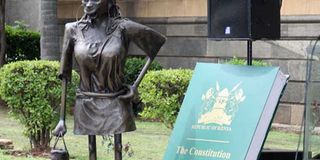Men as key allies in advancing gender equality

We hope that the modalities to implement the 2/3 gender rule will be found and that the deadline of August 2015 set by the Supreme Court will be met. FILE PHOTO | WILLIAM OERI |
What you need to know:
- We hope that the modalities to implement the 2/3 gender rule will be found and that the deadline of August 2015 set by the Supreme Court will be met.
- In Kenya the political will shown by President Kenyatta and his Cabinet is essential.
Finland has a long-term partnership with Kenya in supporting women’s empowerment and realisation of women’s rights.
During the years of our cooperation, many goals have been achieved in Kenya.
The Constitution is a clear statement of the will to support women’s political participation and thus equal possibilities in all areas of life.
In the Executive, 30 per cent of the cabinet positions are held by women. More women than ever before are represented in the National Assembly.
The 1/3-2/3 provision was reached in the County Assemblies in the elections of 2013. Progress has also been made through the flagship programmes of the Mid Term Plan 2 that emphasise gender equality and the mainstreaming of gender across the public sector both at the national as well as the county level.
Furthermore, implementation of the 30 per cent public procurement preference for women entrepreneurs and the provision of funding for women entrepreneurs are important achievements.
In order to combat violence against women, one stop service centres are being set up in health care facilities.
On the occasion of the International Women’s Day, the Embassy of Finland would like to recognise all of these significant commitments Kenya has made to advance gender equality and women’s empowerment.
At the same time, it is important to note that we still have more work ahead of us.
Gender equality has not been fully achieved anywhere in the world. Finland, generally praised for its progress in realisation of women’s rights, is not an exception.
Therefore, the Finnish actors who have participated in the cooperation with Kenya have found the collaboration very rewarding and have learned a lot from the discussions held with Kenyan stakeholders. Let’s continue this cooperation in order to advance the pace of our work.
In the cooperation with Kenya, Finland has shared its experiences about women’s participation in political life.
CONCEPT OF COMPANIONSHIP
Finland was one of the first countries in the world to guarantee women both the right to vote and stand as candidates. In the first parliamentary elections of 1907 altogether 19 women were elected.
This represented 10 per cent of the members of parliament.
There were several factors that contributed to developments on women’s political participation in Finland. The concept of companionship of men and women that had been rooted in the Finnish mindset oriented the public opinion.
This paved way for opening the political space for women. Even today men need to be our key allies in advancing gender equality and women’s empowerment.
At present 42 per cent of the Finnish members of parliament are women. There are no legislated gender quotas for national parliamentary elections.
Political parties have, however, set their own voluntary quotas and are alternating male and female candidates in the party nomination lists.
The number of seats per constituency is based on the proportion of votes received by the parties.
At the same time the Finnish Equality Law establishes 40 per cent gender quotas for the nomination of State committees, advisory boards and other bodies also at the municipal level. The role of this kind of affirmative action has been significant in increasing women’s representation.
We have seen in Finland how women’s role in decision making can benefit the whole socio-economic development of a country.
However, women still struggle more than men in order to balance the political career and family life.
Women politicians in Finland are more often judged by their looks, and their expertise is not necessarily respected in a similar manner as that of men.
For Kenya, we hope that the modalities to implement the 2/3 gender rule will be found and that the deadline of August 2015 set by the Supreme Court will be met.
VIOLENCE AGAINST WOMEN
Among the gravest challenges that Finnish women face is violence. In a recent study by EU’s Fundamental Rights Agency, Finland was found to have levels of physical and sexual violence against women that were at times significantly above the European average.
Almost half of Finnish women (47 per cent) reported having experienced physical and/or sexual violence since the age of 15, compared to a Europe-wide average of 33 per cent. At the same time the barrier to report incidents of violence is still high.
Preventing violence against women and domestic violence should not be left to the state alone.
Civil society is a key ally of Finnish national and municipal governments both in the preventive work and in providing services such as shelter and protection for victims of violence.
Each and every one of us, men and women, boys and girls, can challenge gender stereotypes, harmful traditional practices and discrimination against women.
In Kenya the political will shown by President Kenyatta and his Cabinet is essential.
The writer is the Finnish ambassador to Kenya





